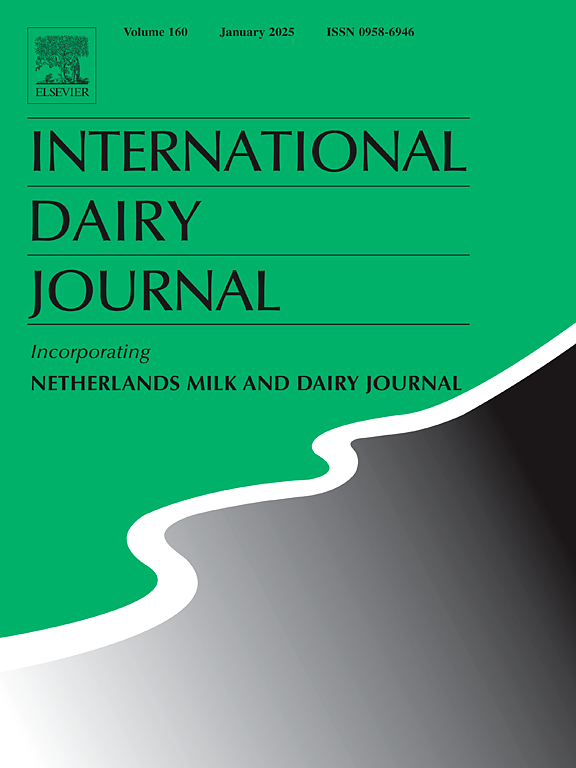A novel two-stage enzyme substrate assay for rapid screening and detection of Listeria monocytogenes in milk and dairy products
IF 3.4
3区 农林科学
Q2 FOOD SCIENCE & TECHNOLOGY
引用次数: 0
Abstract
The contamination of milk and milk products with Listeria monocytogenes has been widely reported globally. This pathogen with a high case-fatality rate of up to 30 %, poses a serious public health concern. Conventional methods for its detection are time-consuming and laborious. Thus, the current research project was undertaken to develop novel two-stage enzyme-based assay for the rapid and selective detection of Listeria monocytogenes in milk and dairy products. In Stage I, the Listeria Selective Enrichment Medium (LSEM) supported the growth of Listeria spp. while suppressing a broad range of background microflora, with presumptive detection achieved via β-D-glucosidase-mediated black color development within 24 h at initial loads as low as 1.35 log cfu/mL. Stage II employed an Enzyme Substrate Medium (ESM) for metabolic confirmation, wherein L. monocytogenes, L. innocua, and L. ivanovii consistently yielded a characteristic green color within 3–4 h. The assay demonstrated strong selectivity, effectively inhibiting E. faecalis, S. aureus, B. cereus, lactic acid bacteria, and Gram-negative contaminants at low to moderate loads, while avoiding false positives even in the presence of high background contamination. Sensitivity studies confirmed a detection limit of ∼1.35 log cfu/mL, with successful recovery from spiked milk within 28 h. Evaluation of 95 milk and dairy product samples revealed L. monocytogenes in two pasteurized milk samples (2.1 % prevalence), with complete agreement between the developed assay and the ISO 11290–1:2017 method. Compared to conventional enrichment protocols, the two-stage approach offered superior inhibitory control over competing flora, minimized assay interference, and reduced detection time by enabling confirmation within ∼28 h. This method provides a rapid, specific, and cost-effective tool for L. monocytogenes surveillance in complex dairy matrices, with potential application in routine food safety monitoring and regulatory screening.
一种新的两阶段酶底物法快速筛选和检测牛奶和乳制品中的单核增生李斯特菌
牛奶和奶制品受到单核增生李斯特菌污染的报道在全球范围内已经广泛报道。这种致死率高达30%的病原体造成了严重的公共卫生问题。传统的检测方法既费时又费力。因此,目前的研究项目是开展一种新的两阶段酶法,用于快速和选择性地检测牛奶和乳制品中的单核细胞增生李斯特菌。在第一阶段,李斯特菌选择性富集培养基(LSEM)支持李斯特菌的生长,同时抑制了广泛的背景菌群,在初始负荷低至1.35 log cfu/mL时,通过β- d -葡萄糖苷酶介导的黑色发育在24小时内实现了假定检测。第二阶段使用酶底物培养基(ESM)进行代谢确认,其中单核增生乳杆菌、无性乳杆菌和伊万诺维奇乳杆菌在3-4小时内一致产生特征绿色。该试验显示出很强的选择性,在低至中等负荷下有效抑制粪肠杆菌、金黄色葡萄球菌、蜡样芽孢杆菌、乳酸菌和革兰氏阴性污染物,同时即使在存在高背景污染的情况下也避免假阳性。灵敏度研究证实,检测限为~ 1.35 log cfu/mL,可在28 h内从加标牛奶中成功回收。对95份牛奶和乳制品样品的评估显示,在两份巴氏杀菌牛奶样品中发现了单核细胞增生乳杆菌(2.1%的患病率),开发的检测方法与ISO 11290-1:2017方法完全一致。与传统的富集方案相比,两阶段方法对竞争菌群具有更好的抑制控制,最大限度地减少了检测干扰,并缩短了检测时间,可以在~ 28小时内进行确认。该方法为复杂乳制品基质中单核增生乳杆菌的监测提供了一种快速、特异性和成本效益高的工具,在常规食品安全监测和监管筛选中具有潜在的应用前景。
本文章由计算机程序翻译,如有差异,请以英文原文为准。
求助全文
约1分钟内获得全文
求助全文
来源期刊

International Dairy Journal
工程技术-食品科技
CiteScore
6.50
自引率
9.70%
发文量
200
审稿时长
49 days
期刊介绍:
The International Dairy Journal publishes significant advancements in dairy science and technology in the form of research articles and critical reviews that are of relevance to the broader international dairy community. Within this scope, research on the science and technology of milk and dairy products and the nutritional and health aspects of dairy foods are included; the journal pays particular attention to applied research and its interface with the dairy industry.
The journal''s coverage includes the following, where directly applicable to dairy science and technology:
• Chemistry and physico-chemical properties of milk constituents
• Microbiology, food safety, enzymology, biotechnology
• Processing and engineering
• Emulsion science, food structure, and texture
• Raw material quality and effect on relevant products
• Flavour and off-flavour development
• Technological functionality and applications of dairy ingredients
• Sensory and consumer sciences
• Nutrition and substantiation of human health implications of milk components or dairy products
International Dairy Journal does not publish papers related to milk production, animal health and other aspects of on-farm milk production unless there is a clear relationship to dairy technology, human health or final product quality.
 求助内容:
求助内容: 应助结果提醒方式:
应助结果提醒方式:


